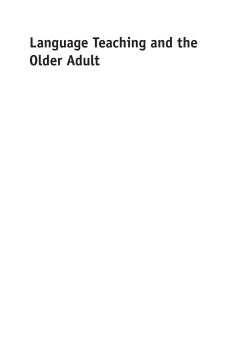
Additional Information
Book Details
Abstract
The aging of the population and the increasing number of older adults pursuing foreign language courses call for a greater understanding of the ways in which these individuals learn foreign languages. This book offers a pioneering contribution to the literature on foreign language education for older adults (aged 60 and over), termed foreign language geragogy. It details an empirical, multidisciplinary study on Japanese older learners of Spanish and focuses on the influence of learning experiences on vocabulary learning strategy use. It discusses the constraints that preconceptions impose on learners, researchers, instructors and administrators, and it offers a set of practical recommendations for foreign language activities for elderly individuals. It also introduces the notion of ‘learner re-training’, an instructional mechanism that contributes to older learners' self-acknowledgment and autonomy development in foreign language learning. The book is directed at teachers and trainee teachers of foreign languages to older adults, and also at education professionals and researchers in the field of foreign language learning in general.
Ramírez Gómez’s work can be described as convincing, relevant, hands-on, and
pragmatic. The book offers great insights into who we are teaching (older adults) and how we are teaching them; it gives ample opportunity to reassess teaching practices but also concrete advice for the classroom (...) any foreign language teacher teaching older adults or creating courses for them should read this book. Researchers interested in FL acquisition and geragogy will also find that this book is an educational gem due to its timeliness in proposing a possible new way forward in teaching the older adult.
Annelie Carslake, National University of Ireland Galway, Ireland
Language Teaching and the Older Adult is compulsory reading for all individuals involved in the teaching of older adults, considering furthermore that educational programs focused on this segment of the population are rising significantly. If those programs intend to be credible, they cannot be coordinated by individuals who lack the theoretical preparation conveyed in Danya Ramírez Gómez’s work.
Maria da Graça L. Castro Pinto, Universidade do Porto, Portugal
In recent years the teaching of second languages has focused more and more on younger learners, while virtually ignoring the growing demographic of much older learners, particularly in developed countries like Japan or Western Europe. Ramírez Gómez's timely book not only redresses this imbalance but proposes a pedagogy – not based on a deficit model of the older learner – that both respects and enlists the older learner’s experience and learning dispositions.
By writing this book, Gomez brings the needs and importance of older people into the spotlight and reminds us that this age group is as valuable and respectable as when they were younger, and that their cognitive, psychological and social needs should be met.
Sahar Farrahi Avval, Iran
This is an excellent introduction to foreign language (FL) teaching for older adults. It provides a thorough overview of the issues facing older FL students and explicit techniques for addressing these issues. It explains why FL teaching for older adults is something we should all be interested in. This book will be of interest to not only teachers, but FL and TESL program coordinators, researchers and even therapists working with older adults as we all prepare to cater to an aging world population.
Danya Ramírez Gómez has a PhD in Linguistics and Language Sciences and has over 10 years of experience working with older adults. She is a member of the Kobe Project on Language Science and L2 Acquisition at Kobe City University of Foreign Studies, and her areas of research include foreign language geragogy and the introduction of notions of theoretical linguistics in the foreign language classroom.
Language Teaching and the Older Adult is a watershed moment in the field of adult education. Ramírez Gómez successfully interweaves that theoretical interface between the study of foreign languages and geragogy, whilst also engaging a practitioner’s lens that culminates in practical recommendations for programme facilitators. This book is a necessary read for facilitators and academics working in adult education.
Table of Contents
| Section Title | Page | Action | Price |
|---|---|---|---|
| Contents | v | ||
| A Note to the Reader | vii | ||
| Glossary | ix | ||
| 1 Introduction | 1 | ||
| 2 Characteristics of the Older Learner: Whom Are WeTeaching? | 38 | ||
| 3 Experience, Foreign Language Learning and the Third Age: The Case of Japanese Older Learners of Spanish | 57 | ||
| Toward a Foreign Language Geragogy | 89 | ||
| 4 Part 1: Lifelong Learning and Education for Older Adults | 91 | ||
| 5 Part 2: Learner Re-training | 112 | ||
| 6 Part 3: The Foreign Language Lesson | 159 | ||
| 7 Recapitulation and Conclusions: The Criticality of a Foreign Language Geragogy | 195 | ||
| Appendix | 203 | ||
| References | 209 | ||
| Index | 229 |
